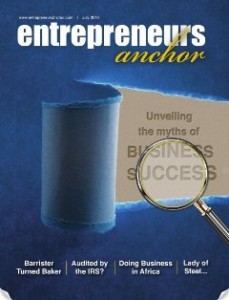Jo-Anne Yau’s Article Published in Entrepreneurs Anchor Magazine: “Trademarks, Copyrights & Patents for the Entrepreneur”
 Jo-Anne Yau has an article published on page 19 of the latest issue of Entrepreneur’s Anchor magazine. The article is a guide for business owners to distinguish between their trademarks, copyrights, and patents, and how to protect each of them. The success of a business depends on its uniqueness and innovation. As an Intellectual Property and Franchising attorney, there are three main ways I help my clients protect their ideas.
Jo-Anne Yau has an article published on page 19 of the latest issue of Entrepreneur’s Anchor magazine. The article is a guide for business owners to distinguish between their trademarks, copyrights, and patents, and how to protect each of them. The success of a business depends on its uniqueness and innovation. As an Intellectual Property and Franchising attorney, there are three main ways I help my clients protect their ideas.Trademarks
Trademarks are a fundamental necessity for a business. A trademark is any feature that a consumer uses to identify where their products or services originate. The most common trademarks are the business name, the logo, and the slogan. However, savvy entrepreneurs come up with a number of ways to identify themselves to their customers, like having a unique uniform, or clever product packaging. Even sounds, like NBC’s 3 chimes, can be trademarked.
It is a myth that a company has to use the trademark before a trademark application can be submitted. The truth is that the business cannot claim any rights to a trademark until it has been used. Whenever possible, I encourage my clients to begin the trademark process as early as possible, since it could take about a year for an application to move through the system. During this year, almost all my clients begin using the trademark in commerce, thus putting it in a position for registration.
How do you know whether another party is already using a name, logo, or slogan? A trademark’s availability is not guaranteed, just because the business is registered with the State’s Division of Corporations. It is also not enough to have purchased a domain name. Only a thorough trademark search can reveal existing trademarks that are the same or confusingly similar. While there are trademark search companies that can conduct this search, only a trademark attorney can give a legal opinion as to whether another trademark is “confusingly similar.”
As soon as a company decides on a name, logo, or slogan, the (TM) symbol should appear next to it. Once a trademark is registered with the U.S. Patent & Trademark Office, the (R) symbol should be used. These symbols put the public on notice about the status of the mark as a registered trademark, and helps prevent infringement.
Trademarks are vital for a business planning to expand and grow. Franchising and licensing options depend on protected business methods and registered trademarks.
Copyrights
Copyrights prevent other parties from copying any creative work, and calling it their own. Copyrights in the business sector pertain mostly to written materials, such as Policy & Procedure Manuals, Employee Handbooks, and website content.
Copyright registration also takes about a year to process. Thus, for content that is likely to be frequently edited, updated, or changed, I do not recommend registration. However, where the content remains relatively static, and the written work has creative value, I would recommend copyright registration. Particularly in an era where others can access digital formats of the work, and “Copy & Paste” the material, copyright registration becomes more important to prevent misappropriation.
Patents
By far the most expensive of the three, patents prevent new and useful devices. The most common type of patent is a utility patent, which protects the way an invention is put together. It is essentially the “recipe” for building the product. Ironically, I do not recommend patents for food recipes. Because patents are available to the public, it would not be wise to publish a successful recipe for competitors to access. Rather, food recipes are best protected by trade secrets.
As opposed to utility patents, there are also design patents. These are much less common that utility patents, because they only protect the functional design of a product. Also, utility patents are valid for 20 years, whereas design patents are only valid for 14 years. Despite the limited scope of protection of design patents, however, they do serve a particular purpose, and offer protections not available under utility patents.
As with trademarks, a patent search is essential to determine whether the invention has already been disclosed. The Patent Office requires disclosure of even similar inventions, and the inventor must explain why the present invention is a new, useful improvement on existing inventions.
To date, it takes at least a month to properly prepare a patent application. Once submitted to the U.S. Patent & Trademark Office, it takes about 25 months before the inventor should expect to get a response. During that time, however, the inventor may claim “Patent Pending” stauts, and begin to promote and sell the product. A word of caution, however: without patent pending status, if an inventor uses, describes, sells, or promotes the invention in public, that inventor will only have one year to file a patent application. After that time, the Patent Office will not allow an application to be submitted.
Businesses have many obstacles to face. It is always beneficial in attracting customers to offer unique and new products and services. To keep competitors from exploiting your competitive edge, protect yourself properly with trademarks, copyrights, and patents.
Leave a Reply